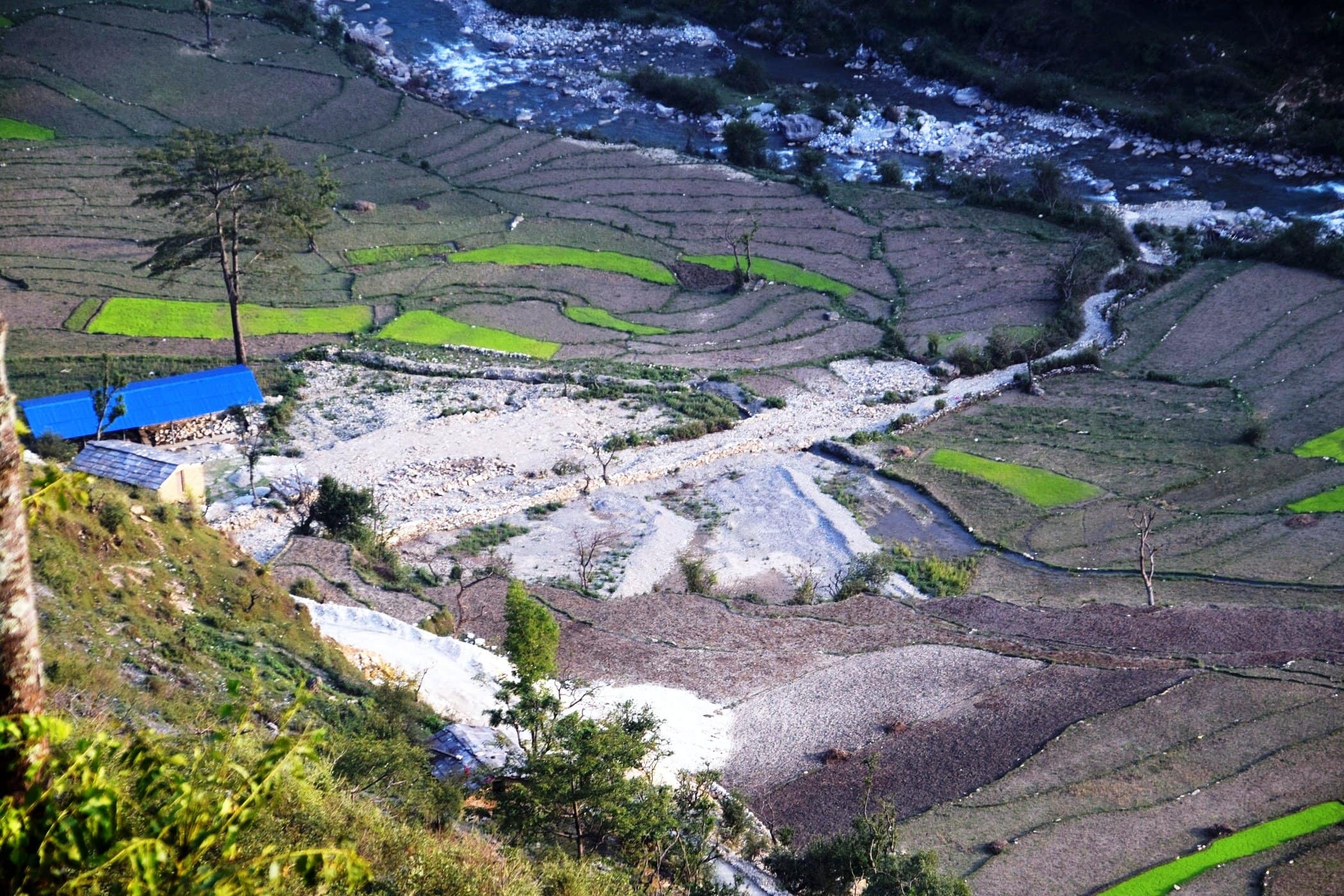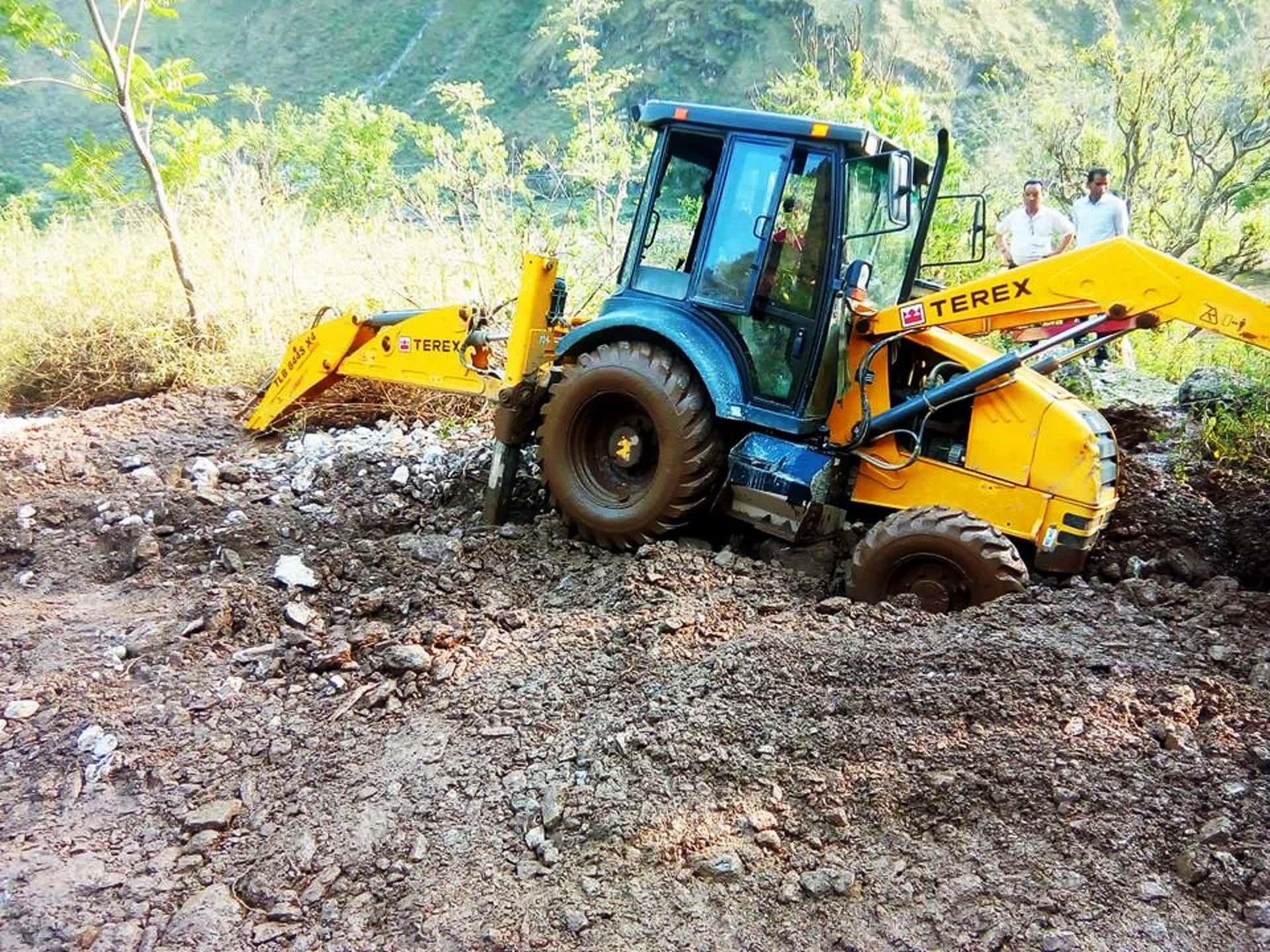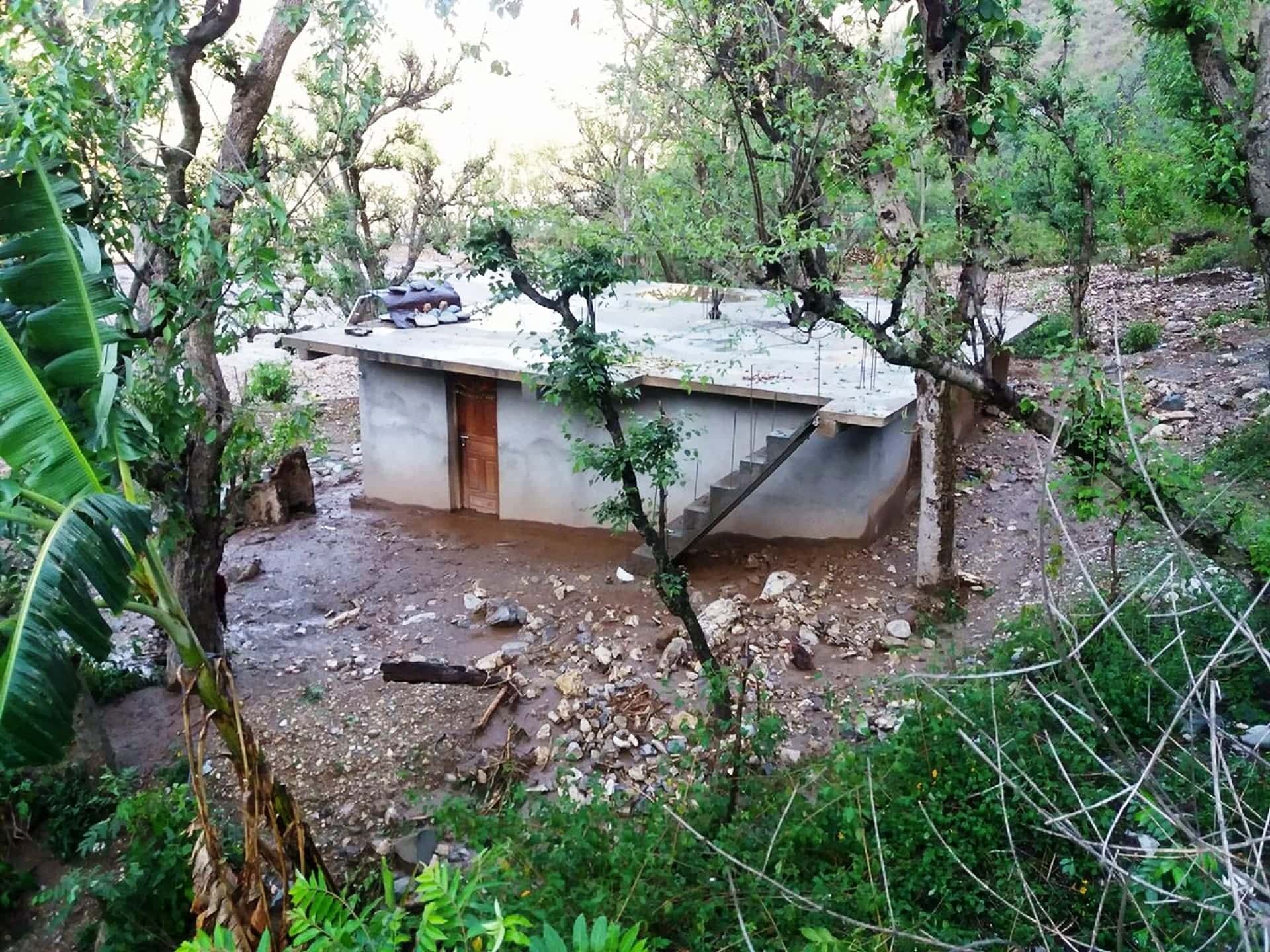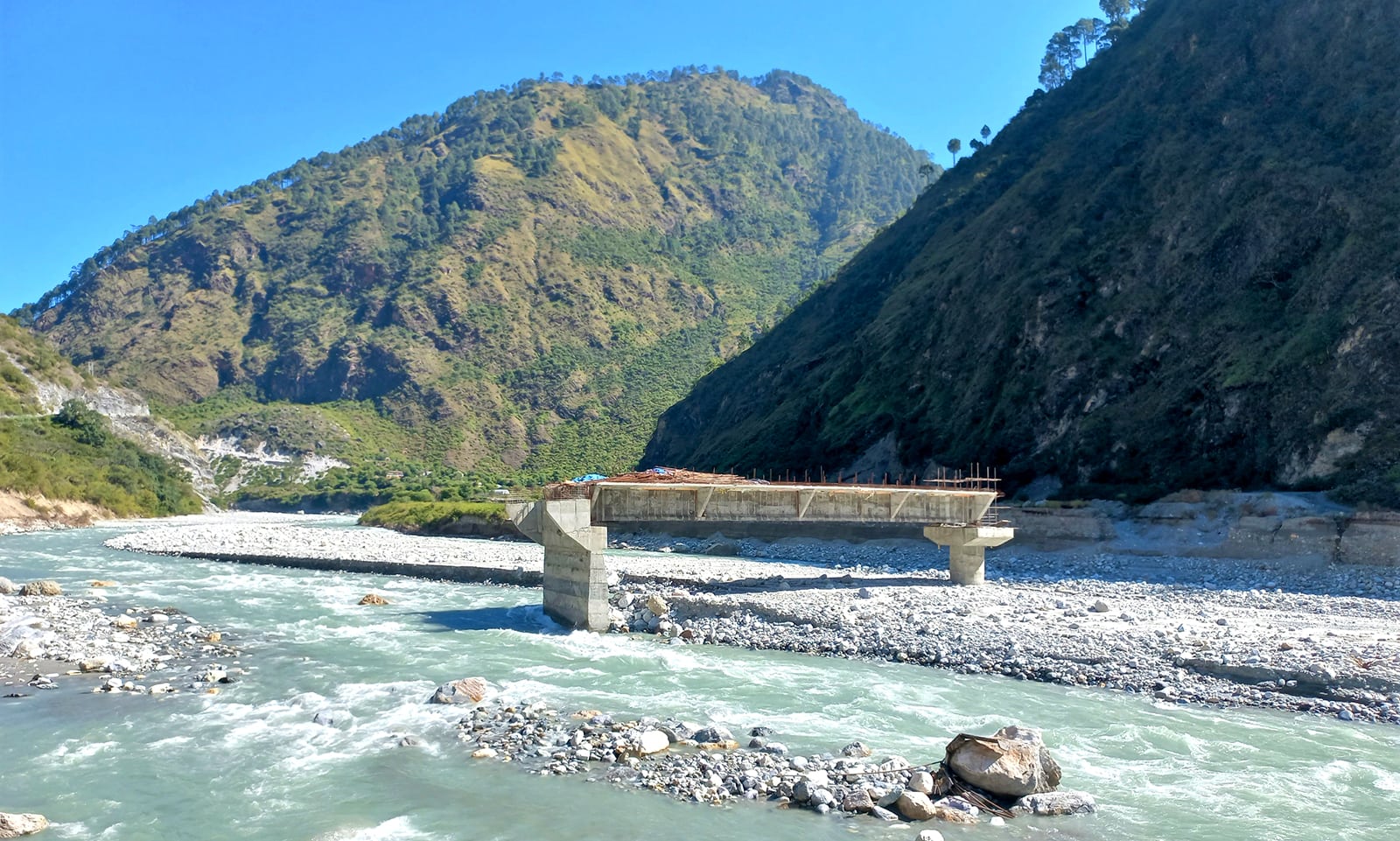The rampant use of dozers has caused loss of land and damage to trees affecting the ecological balance in Bajhang district. The rockfall that occurs during the construction of roads has caused substantial damage to the fertile lands and other vegetation, and infrastructure. People, who are at high risk of landslides and adversities, are lobbying their plan of shifting their village.
-Basanta Pratap Singh : Centre for Investigative Journalism-Nepal
-
- May 8, 2018 – Sub-engineer Narayan Dahal lost his life in a landslide at the Chainpur-Taklakot road section in Ramaili.
-
- May 6 – Five people, including four of the same family, died when they were swept away by floods — triggered by incessant rain and hailstorm — in the Guhe river in Thalara village development municipality. Floods swept away five houses and damaged the Juilgad small hydro canal that led to the disruption of electricity supply. The Namadev Primary School building, some 800 ropanies of land in Kedarsiu, Durgathali, Thalara, and Chhabis Pathivara were inundated. Nine goats died in floods.
-
- Three people died when floods triggered by incessant rainfall swept away a jeep at Chauthiya river of Karansebeda on May 2, 2018. Floods inundated over three thousand ropanis of land and killed more than 50 domestic animals. The floods caused a loss of more than Rs. 20 crores.
-
- April 27 – The incessant rain triggered floods inundated more than 2,500 ropanies of land destroying crops in Malumela, Luyata, Matela, and other villages of Sabik. The paddy fields turned into river bank incurring a total loss of more than Rs. 30 crores.
10 people lost their lives in ten days in between April 27 to May 8, 2018, in Bajhang. More than six thousand 300 ropanies of land have been turned into river banks. Crops worth Rs 50 crores have been destroyed. Several houses have been inundated or buried, and infrastructure destroyed. “Heavy rains trigger floods, resulting in casualties and a huge loss of property,” says a common man.

Bhawani Primary School building and fields in Bungal Municipality were destroyed by the mud and rocks dumped during the road construction. The mud and rocks were swept away by the rainfall. All Photos : Basanta Pratap Singh
People might raise their eye-brows asking: Are floods a natural phenomenon during the months of March or April? How can two hours of rainfall create such havoc? What brings floods to small streams? If this is the situation in March and April, what would be the condition during monsoon? These are some of the common queries and concerns that are being raised in gatherings, intersections, market-places, tea shops, among other places.
A youth litterateur, Yugin Bivek expresses sarcasm on his Facebook saying, “The craze for development has been so immense that bulldozers are on the move digging and excavating the hills. The concerned authorities are neither worried about the consequences of the settlements, nor they are concerned about the crops and vegetation…forget about the environment.”
Ninety-year-old Paramananda Joshi of Malumela, Thalara village municipality says, “Never had in all my life seen or heard about floods and landslides in this village.” He expressed astonishment when he narrated the ‘terrible incident’ of April 27 as a new experience for him at this age. The flashfloods triggered by two hours of rainfall washed away crops in around 200 ropanis of land possessed by 45 families. Locals fear that the fertile land of 800 ropanies would turn into a barren land due to landslides and floods.
People in Tallodhikla of the same village municipality are extremely worried after the Guhekhola river — flooded for the first time in its history — killed five people in April. “They (five deceased) were crossing the river when flash floods triggered by a rainfall of approximately 45 minutes swept them away,” 54-year-old Ramdal Mijar said. Stating that the river was almost dry in the evening, he said in astonishment, “This, in fact, is a brook, which is often dry except a few months during monsoon. How did it happen?”
Madan Raj Joshi, who has been teaching at a local Saraswati Primary School – situated just beside the Guhekhola river — expressed the astonishment saying, “I have been teaching here for the last 24 years. But I have not in my wildest dreams imagined that this stream would be so malevolent.”
Meanwhile, the Chaithya river, which was almost dry till the afternoon of May 2, 2018, washed away a jeep in the evening. Flabbergasted locals said they had not even imagined that this river would go to that extent. Local Dipak Raj Joshi said, “This is like a hallucination. I cannot even believe that this stream swept away a jeep.”
The consequence of the haphazard construction
Local Dipak Raj Joshi states that this is the result of the haphazard digging and construction of the three road trails just above this stream. “The landslide is nothing but the consequence of unsystematic work. The rainwater swept away the rocks and mud that was piled up while digging the roads,” he said.

A house buried by landslides after rainfall at the Jay Prithvi Municipality.
Concurring Joshi’s views, Sunil Kumar Gupta, Soil Conservation Officer said, “The cause of landslides and floods is due to the haphazard construction of roads, which has obstructed the natural flow of rainwater.” This, he claimed, was the consequence of the haphazard use of dozers in extremely sensitive areas while constructing the roads. He warned that even a 140 ml rainfall will trigger a landslide in the area.
This has been prevalent in the entire district. The floods in April turned thousands of ropanis of fertile paddy fields into barren lands. Moreover, there have been landslides in various places of the district. “The situation has become atrocious. It’s become almost unpredictable,” Narendra Upadhyaya, a teacher in Jaya Prithivi municipality, adding, “Five to six roads have been carved at a distance of 40 to 50 meters.” Heaps of rocks and soil can be seen everywhere.
District Soil Conservation Officer, Gupta says, “The entire episode has been intimidating now. You never know what will happen due to the haphazard construction of roads.” He warned that loss can go beyond imagination if there is a heavy rainfall during monsoon.
There have been no integrated details about the construction of roads in Bajhang district. Ironically, the local concerned authorities neither have the correct information about the ongoing construction of roads, nor do they have any thoughts about the impacts on human settlement, and environment. This is purely happening in the name of development.
This, however, does not mean that the government lacks policies and programs. Several acts and regulations concerning environmental protection have been made. There has been a provision of making an Initial Environmental Examination (IEE) and the Environmental Impact Assessment (EIA) before kicking off big projects, including roads.
According to the Local Body Resource Mobilization and Management Working Procedures 2069 prepared by the Federal Affairs and Local Development Ministry, a project should meet the Environment Protection Act 2053, Environment Protection Regulation 2054, and Social and Environmental Guidelines 2065 before its implementation.
Moreover, the Local Development Ministry on July 6, 2010, had directed the concerned authorities to allocate the budget as per the District Transportation Pilot Project after analyzing its environmental and technical aspects before initiating construction of roads in the districts. Similarly, the District Transportation Pilot Project Directives brought by the Local Development Ministry has clearly mentioned about the use of labor technology in the construction of roads.
The Federal Affairs and Local Development Ministry on June 3, 2013, had issued a circular to all the District Development Committees instructing them to identify about the use of heavy equipment, including ‘excavators’ by forming a technical committee under the coordination-ship of the chief of the district technical office. The ministry had directed the committee to minimize the use of heavy equipment and instructed the concerned authority to use dozers only in the presence of an engineer.
The Federal Affairs and Local Development Ministry has prepared the Local Governance Structure 2070 to ensure that the construction and development works are carried out in an environment-friendly approach. It has also suggested solutions to ensure that the construction works are environment-friendly.

Houses damaged by landslides in Thalara village municipality-9.
These rules and circulation have not been adhered to in Bajhang. “The authorities concerned have issued a circular barring the use of heavy equipment without acquiring approval from the district technical committee. However, dozers have been used rampantly without acquiring the approval or assessment,” said Nripraj Joshi, Chief of the District Technical Committee. He said that the haphazard use of dozers is having an adverse environmental impact in the district.
The Environmental Department of the Federal Affairs and Local Development Ministry, and the Ministry of Environment had sent a letter to the District Development Committee in 2073 seeking clarification about the rampant use of dozers in Bajhang district after the Centre for Investigative Journalism (CIJ) published a report on the issue. The Ministry had then asked the District Development Committee to stop the use of dozers without adopting the required procedures. However, the instruction was ignored. “We held several discussions on the issue,” Birendra Bahadur Singh, information officer at the District Development Committee said. “We, however, did not respond since we were not in a position to do so,” he added.
If the data available at the local level is to be considered, the construction of some 165 roads is underway in the district. Moreover, the rampant use of dozers on the roads namely main road, branch roads, feeder roads, rural roads, agriculture roads, among others, has created chaos among the people. However, despite the rapid construction of roads in the district, the remote village of Saipal has not been connected by roads so far.
Locals are unaware about the length of the roads being constructed in their area. “We have absolutely no idea about the distance of the road since we have not had a chance to see the sketch,” said Ranga Lal Sarki, Chief Administrative Office at Mastaa village municipality adding, “We have constructed the road to necessitate the need”.
So far, 53 dozers are being used in the construction of roads in 11 local levels of the district. While three dozers are used in Thalara, Surma, Mastaa, Chhabis-Pathivera, Durgathali and Kedrasiu village municipalities, nine are used in Bungal village municipality. One dozer has been used in Khaptad Chhanna village municipality. Likewise, while five dozers are being used simultaneously in Talkot, two dozers are involved in road construction in Bithad-Chir village municipality. Similarly, five dozers are being used at the Rupatola Dhuli stretch of Taklakot of Chainpur and four in the Ruwatola stretch. Kalanga hydro project and Sunigad hydro project have been using four dozers to construct the road.
Roads displacing people, ironically
Madan Rokaya of Jay Prithivi municipality-6, who heads a 13-member family, was least worried since he possessed the land that sufficed for his family for the whole year. His land’s production was sufficient to meet the family’s requirements, including his children’s school fees.

A dozer gets stuck while trying to clear the mud and rocks at the Jay Prithvi Highway.
The situation, however, has reversed now. Except for his house built on four annas of land, Rokaya’s family has been rendered landless, literally! “We even used to share our crops with the neighbors,” an anguished Madan complained adding, “Initially our happiness knew no bounds to realize our dreams of a road in our village. Now I am ruined.” The gravel and mud dug out from the Tamail-Chainpur section of the road have covered almost 14 ropanis of his fertile land making them totally unproductive. Since then, his family has been working on daily wages.
Woes continue. More than 250 ropanis of land belonging to over 30 families in Subeda village, and considered as the most fertile in the district have turned barren due to the construction of roads rendering people landless. 12 concrete sheds have been destroyed due to the heaps of soil and rocks.
The construction company — Lama Golden JV Pvt. Ltd – is least bothered despite victims’ repeated complaints. “Fertile lands of several families have been either washed away or buried by mud and rocks,” victim Singh Bir Rokaya said, adding, “We are helpless, mere spectators. The construction of roads came as an adversity.”
Subeda is a representative village. If the data prepared by the District Agriculture Development Office is to be considered, more than 1,800 families’ lands in 40 villages of the district have been ruined by the rampant use of dozers in the name of road construction. The number of landless people has been increasing annually. More than four thousand ropanis of fertile lands in Jinnada, Samdeu, Bhatekhola of Mastaa village municipality; Dugri, Golai, Basti, Subeda, Sutiya and Selakhet of Jay Prithivi municipality; Gothkhola, Aichelibagar, Kalukheti, Chhatarbasti, Bina and Bedupata of Chhaanaa village municipality have become unproductive from the mud and rocks coming out from the construction sites.
Mangal Bahadur Khadka of Chhaanaa village municipality says, “Most of the fertile lands have been covered with rocks and muds. Moreover, several ropanis of lands have been cut by the road.” He informed that lands of over 125 families have been completely encroached upon.
Likewise, fertile lands belonging to 55 families of Thing, Malumela, and Aambagar villages of Thalara village municipality have been destroyed by the construction. Sixty-three houses are at risk of landslides. “We are at high risk. If this continues, we will have no option than to migrate,” said Nishwo Prakash Joshi, a local. Similarly, over 600 ropanis of productive land in Gandaki Bazar, Deura, Rayal, Bagthala, Sainsu, among others places of Kedarsiu village municipality have been buried with mud and rocks, according to Lokesh Bhandari, chairman of ward no. 4.

Road construction-generated landslides bury paddy fields destroying crops in Malumela of Thalara village municipality. The human settlement below the fields is at high risk of landslides.
According to the district agriculture development office, several ropanis of fertile land in Durgathali and Chabisa-Pathibhera village municipality of Bungal municipality have been destroyed due to which several families have been rendered landless. “More than eight thousand ropanis of land have been ruined,” Chief of the Agriculture Development Office Rajesh Kumar KC said. “The number could go even higher,” he added.
“There has been a rampant use of bulldozers. Fertile lands have been converted into barren lands. What’s the purpose of such developments if people are displaced and fertile lands are destroyed?” KC queried adding, “Several irrigation structures have been destroyed in the name of development causing serious environmental impact,” he complained.
Impact on irrigation and drinking water
The district boasts of 84 large-scale irrigation projects, including 64 constructed by the Irrigation Division Office, and 20 constructed by the Community Irrigation Project. Besides these, there are 366 other irrigation projects constructed by various NGOs. According to the District Agriculture Office, the district has around 450 functioning irrigation projects in Bajhang district. These projects have been providing irrigation facilities to over nine thousand 915 hectares of land out of the total 28 thousand 214 hectares of cultivable lands.

Landslide generated by the construction of road destroys a drinking water project pipe and water tank.
So far, more than 283 projects have been destroyed because of roads construction in the district. “Around 64 percent of the canals have been destroyed,” senior agriculture development officer Rajesh Kumar KC said. “Destruction of the remaining irrigation projects cannot be ruled out in a year if the bulldozers continue to excavate in a similar manner,” he warned. In fact, KC along with other locals repeatedly apprised about the adversities to the political party representatives and development bodies but to no avail. “They told me that destruction is not unusual in a development effort. Destruction is transient, development is permanent,” KC said.
Adding more woes to the locals, several drinking water projects have been damaged due to the rampant construction of roads. The Padamjelya Drinking Water Project was completed at the cost of Rs. 35 lakhs at Sireta of Thalara village municipality on Magh 2074. Over 72 families, who were deprived of water for a long time, were directly benefitted from the project. Two months later, the pipeline and other structures of the project were damaged during the road construction. “We volunteered to construct the drinking water project with the hope of getting sufficient water. Our dreams of getting sufficient water have been shattered,” Bijay Joshi, a local of Sireta said.
The road construction damaged two drinking water projects in Sabik Malumela village in the last two years. This has compelled the people to rely on rivers and wells, which have contaminated waters, according to Bishnu Pokhrel, advisor of district coordination committee rural water resources management project. Pokhrel said that rampant construction of roads has also resulted in drying of the water sources.
Prem Bahadur Singh, a non-gazzeted officer at the district drinking water and cleanliness division office, said that they have so far received more than 150 complaints against the road construction. “In fact, the number of projects that have been damaged during the road construction could be even higher. However, due to lack of manpower, we have not able to collect the exact data.”
Local’s voice shifting their village
“It’s been three years that we have not been able to take a sound sleep. We never know when our entire village would be swept away by landslides. In fact, we are compelled to rush to open fields by carrying toddlers,” Bishwo Prakash Joshi of Thalara-9 apprised Trilochan Bhatta, Chief Minister of Province-7, during a recent meeting at the latter’s office. A group of people, along with Joshi had reached the Chief Minister’s office asking him to shift the villagers to a safe place.

Road construction-spilled and dumped mud and rocks bury crops and fields following a rainfall at Thalara Malumela.
They apprised the Chief Minister that around 200 people of 25 houses in the village are at high risk. Local Hari Narayan Regmi told the Chief Minister that the village has been entrapped from both sides. “While the Seti river floods during monsoon cutting the lands, there are chances of landslides,” he said.
The construction of the Jadar-Koiralkot road that began in April 2015 has put the village at high risk since eight houses have already been destroyed so far. Around 60 ropanis of land have been buried with the soil and rocks. Likewise, the mud-slip also damaged drinking water and irrigation projects worth Rs two crores.
Likewise, the ongoing construction of the Pankot-Paudi road, some 50 meters below the Jadar-Koiralkot road, has further heightened the risk of landslides. “The land between the two roads is in danger of landslides. If this is the case, the entire village will be washed away,” warned Balaram Bhandari, a local.
Around 40 villages of Bajhang are at high risk due to the construction of roads and rampant use of bulldozers. The Thing village, a settlement of some 63 families, in Thalara village municipality is also at high risk of landslide. “We are trying to sort out the issue. There is a high risk of casualty,” warned Bhuwaneswor Upadhyaya, Chairperson of the Thing village municipality.
The Talkoti Gad mini-hydro project stopped its operations two years ago after the canal was damaged during the construction of the Pankot-Talkot road. More than 900 households were benefitted from the project, which was built from the joint initiatives of the locals and the project side at the expenditure of Rs 2 crores 50 lakhs. Even mothers of small babies had lent their helping hands by walking for more than five hours to carry electricity poles with the hope that they would get electricity. However, unfortunately, they are compelled to burn oil lamps now. “We carried poles along with our babies notwithstanding the temperature and other adversities. The road has shattered our dreams,” said Pausara Sunar of Talkot.
Hitting the ‘lifeline’
Jaya Prithvi Highway is the only lifeline that connects Bajhang with other districts. All essential goods, including food, clothes, medicines, construction materials, salt, and oil, etc are brought through this highway from the Terai. Therefore, this highway is dubbed as the “lifeline” of the district. Black-topped three years ago, this highway and other newly constructed rural roads are at high risk of being blocked due to landslides.

A concrete house is buried in the landslide generated by the construction of a road in Kedarsiu village municipality.
This highway was obstructed for more than five days in between April 27 to May 5, 2018, due to incessant rainfall. Several feeder roads have been constructed above this highway, which goes from Bagthala to Chainpur. “The mud and rocks piled up in the course of the construction of sub roads are washed away by the rain thus obstructing the highway,” said Lalijan Khanal, chief engineer at the road department office, Baitadi. “Consultation and coordination should have been done with the concerned office before constructing the roads, which are parallel with the highway. The roads should not have been constructed without analyzing the environmental impact,” he said adding that he had repeatedly written to the then district development committee apprising him about the impact of the rampant use of dozers. “My request was not heeded,” he complained.
The highway was obstructed for 38 days during a period of three months from Asar to Bhadra in 2074 due to which five patients, who have been referred to other hospitals, lost their lives on the way.



